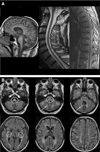Adult polyglucosan body disease: Natural History and Key Magnetic Resonance Imaging Findings
- PMID: 23034915
- PMCID: PMC4329926
- DOI: 10.1002/ana.23598
Adult polyglucosan body disease: Natural History and Key Magnetic Resonance Imaging Findings
Abstract
Objective: Adult polyglucosan body disease (APBD) is an autosomal recessive leukodystrophy characterized by neurogenic bladder, progressive spastic gait, and peripheral neuropathy. Polyglucosan bodies accumulate in the central and peripheral nervous systems and are often associated with glycogen branching enzyme (GBE) deficiency. To improve clinical diagnosis and enable future evaluation of therapeutic strategies, we conducted a multinational study of the natural history and imaging features of APBD.
Methods: We gathered clinical, biochemical, and molecular findings in 50 APBD patients with GBE deficiency from Israel, the United States, France, and the Netherlands. Brain and spine magnetic resonance images were reviewed in 44 patients.
Results: The most common clinical findings were neurogenic bladder (100%), spastic paraplegia with vibration loss (90%), and axonal neuropathy (90%). The median age was 51 years for the onset of neurogenic bladder symptoms, 63 years for wheelchair dependence, and 70 years for death. As the disease progressed, mild cognitive decline may have affected up to half of the patients. Neuroimaging showed hyperintense white matter abnormalities on T2 and fluid attenuated inversion recovery sequences predominantly in the periventricular regions, the posterior limb of the internal capsule, the external capsule, and the pyramidal tracts and medial lemniscus of the pons and medulla. Atrophy of the medulla and spine was universal. p.Y329S was the most common GBE1 mutation, present as a single heterozygous (28%) or homozygous (48%) mutation.
Interpretation: APBD with GBE deficiency, with occasional exceptions, is a clinically homogenous disorder that should be suspected in patients with adult onset leukodystrophy or spastic paraplegia with early onset of urinary symptoms and spinal atrophy.
Copyright © 2012 American Neurological Association.
Figures



Comment in
-
Childhood presentation of "adult" polyglucosan body disease: normal GBE1 sequence with no glycogen branching enzyme activity.Ann Neurol. 2013 Feb;73(2):317-8. doi: 10.1002/ana.23854. Ann Neurol. 2013. PMID: 23526558 No abstract available.
-
Reply: To PMID 23034915.Ann Neurol. 2013 Feb;73(2):318. doi: 10.1002/ana.23855. Ann Neurol. 2013. PMID: 23526559 No abstract available.
References
-
- Robitaille Y, Carpenter S, Karpati G, DiMauro SD. A distinct form of adult polyglucosan body disease with massive involvement of central and peripheral neuronal processes and astrocytes: a report of four cases and a review of the occurrence of polyglucosan bodies in other conditions such as Lafora’s disease and normal ageing. Brain. 1980;103:315–336. - PubMed
-
- Klein CJ, Boes CJ, Chapin JE, et al. Adult polyglucosan body disease: case description of an expanding genetic and clinical syndrome. Muscle Nerve. 2004;29:323–328. - PubMed
-
- Klein CJ. Adult polyglucosan body disease. Seattle, WA: University of Washington; 2009. - PubMed
-
- Cafferty MS, Lovelace RE, Hays AP, et al. Polyglucosan body disease. Muscle Nerve. 1991;14:102–107. - PubMed
-
- Sindern E, Ziemssen F, Ziemssen T, et al. Adult polyglucosan body disease: a postmortem correlation study. Neurology. 2003;61:263–265. - PubMed
Publication types
MeSH terms
Substances
Supplementary concepts
Grants and funding
LinkOut - more resources
Full Text Sources
Other Literature Sources
Medical
Research Materials

